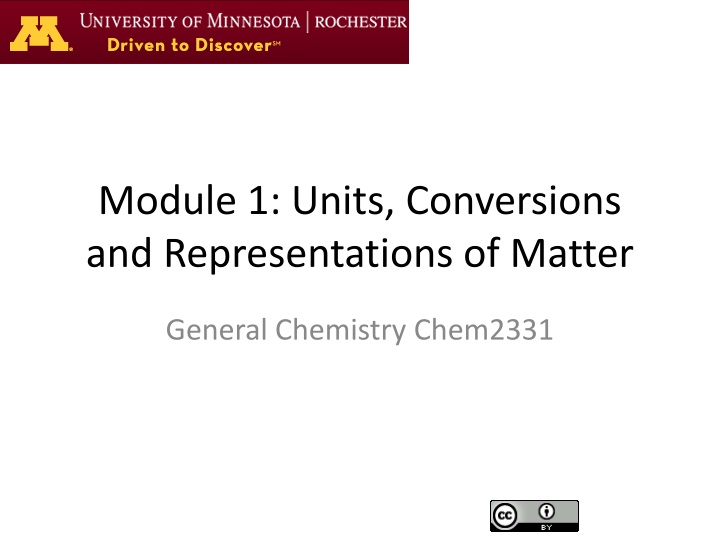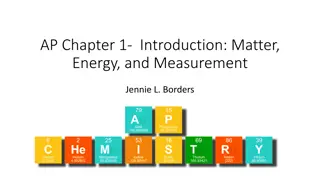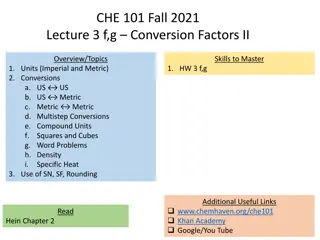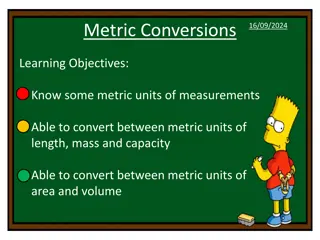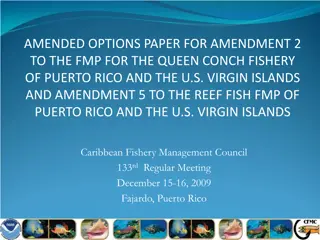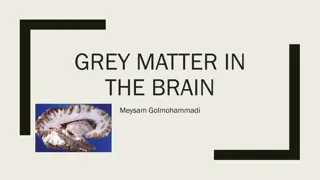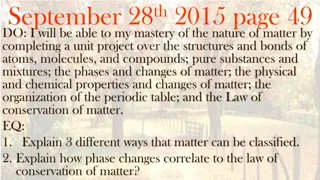Units, Conversions, and Representations of Matter in General Chemistry
Explore units, conversions, and representations of matter in this General Chemistry module. Learn about exponential notation, scientific notation, density calculations, and more. Dive into the world of chemistry with in-depth explanations and examples.
Download Presentation

Please find below an Image/Link to download the presentation.
The content on the website is provided AS IS for your information and personal use only. It may not be sold, licensed, or shared on other websites without obtaining consent from the author.If you encounter any issues during the download, it is possible that the publisher has removed the file from their server.
You are allowed to download the files provided on this website for personal or commercial use, subject to the condition that they are used lawfully. All files are the property of their respective owners.
The content on the website is provided AS IS for your information and personal use only. It may not be sold, licensed, or shared on other websites without obtaining consent from the author.
E N D
Presentation Transcript
Module 1: Units, Conversions and Representations of Matter General Chemistry Chem2331
Outline Module 1. Video 1. Module 1. Video 3. 1. Representations in Chemistry 2. Exponential and scientific notations 3. Metric and SI system 4. Conversion between metric system 1. Linear conversions 2. Square conversions (surface) 3. Cube conversions 4. Conversion of Combined units: density 1. Physical and chemical changes 2. States of matter 3. Classification of matter Module 1. (Optional) 1. Significant figures Module 1. Video 2. 5. Conversion between non-metric systems: Imperial system 6. Temperature 7. Units of mass: mole, gram, particle Chem 2331: General Chemistry 2
Representations in Chemistry Identify the submicroscopic, the macroscopic and symbolic representation NaCl Set 1: H2 + O2 H2O Set 2: Does the symbolic representation refer to sub microscopic or macroscopic?
Exponential and Scientific Notation Change these numbers in exponential notation into scientific notation. a. 5,420 x 103= b. 0.020 x 103= c. 0.00492 x 10-12 = d. 0.0067 x 10-4 = e. -870 x 10-4 = f. -602 x 1021 = g. -0.0123 x 10-2= Chem 2331: General Chemistry 4
Exponential and Scientific Notation Write the result in scientific notation (without calculator) a. 5 103x 5 102= b. 5 103+ 5 102= c. 5 103x 5 10-2= d. 5 103+ 5 10-2= e. 5 103/ (5 102)= f. 5 103/ (5 10-2)= g. 5 103+ 5 103/ ( 5 102) Chem 2331: General Chemistry 5
Surface and volume Convert the following quantities of length, surface or volume a. 0.01 nm into km b. 103 m2 into m2 c. 10-1 nm3 into dm3 Clicker If a certain volume in cm3 is doubled, will this same volume be doubled in m3? A. It will be doubled B. It will be less than double C. It will be more than double
Density Which of the following correctly shows how to convert a density of 20.1 g cm-3 to units of kg m-3? A. B. C. D. E. Chem 2331: General Chemistry 7
Density Challenging question: If the density of a certain spherical atomic nucleus is 1.0 1014 g cm-3 and its atomic weight is 4.002 atomic units, what is its radius in nm? (Note 1 a.u. = 1/6.022E23 = 1.66E-24 g) Isn t that a huge density? Why materials do not have that much density? (Hint: the radius of helium is 0.032 nm)
Real life comparisons http://htwins.net/scale2/ A) Size of Boeing747 C) Size of the Sun If an atom were as big as a tennis ball. How big an actual tennis ball would be? (Hint: atom size is around 0.1nm) B) Size of Texas D) Size of Solar System
Real life comparisons http://htwins.net/scale2/ How empty is an atom? If an atomic nucleus had the size of a tennis ball placed in the middle of this classroom. Where would you find the electrons? (Hint: nucleus size is 1E-15m and atom 0.1nm) A) The walls of the classroom C) Around the block Broadway w/ 1st Ave. B) Around the edges of Rochester Downtown D) At the borders of Minnesota
Real life comparisons http://htwins.net/scale2/ How fast does an atom move? If each vibration of an atom took 1 second? How long would a second take? (Hint: Carbonyls vibrate on IR at 1500 cm-1, this unit of wavenumber can be converted to frequency which is around 1E-12 second/vibration) A)Your College years C) Since the first hominid B) Modern Era D) The age of the universe
